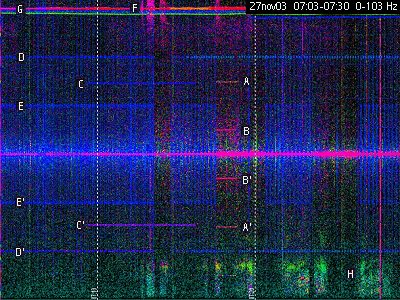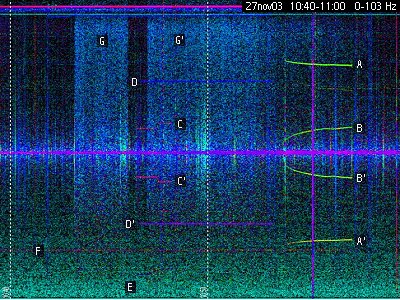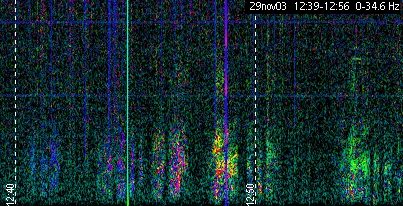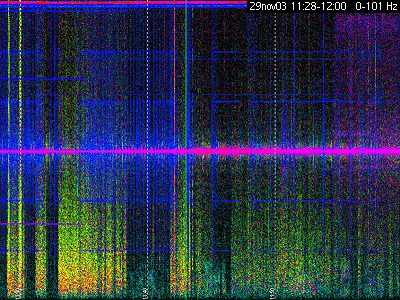
In a "normal" day we can usually receive these signals:
1) 50 Hz main frequency, always presents, everywhere
2) 50 Hz signal changes in intensity in the time
3) 100 Hz (50 Hz x 2) changes direction in the time
4) some tones travel as LSB of 100 Hz tone
5) a weak static
6) noise coming from mains: it appears as AM modulation of 50 Hz tone: upper part is specular to lower part
7) same kind of noise of point 6: two different colors identify two different source direction
8) too strong to be a static: probably a mains stroke
9) a green hiss below 10 Hz: its amplitude is correlated to 50 Hz tone intensity, then brought by mains

A big amount of mirrored signal comes by mains:
A-A') and so on for B-B', C-C', D-D', E-E': many strong tones are present in the ground. They are normally 50 dB below the 50 Hz tone and comes from different directions.
F) 100 Hz tone seems to be a carrier of violet noise, not detected in correspondence of 50 Hz
G) two LSB subtone from different directions (green a nd blue)
H) fascinating: a strange noise below 12 Hz. Acquired in a wave file and accelerated 63 times it sounds similar to an human lament .... someone ask help from underground? :-) Look at this sequence: it appears to be correlated sometimes with start/stop mirrored sequences. I suppose it comes from mains.

Not always they are mirrored to 50 Hz, sometimes to first mains harmonic:
A-A') and so on for B-B', C-C', D-D'. Various and variable tones. Perhaps generated by electric engines. All mirrored to 50 Hz.
E) strong hiss below 10 Hz: its intensity is correlated to 50 Hz one
F) weak tone at 16.6 Hz, not mirrored (perhaps a real signal). Norwegian railways or simply 50 Hz divided for 3?
G-G') blue wide band noise, mirrored to 100 Hz. In this case the first harmonic seems to be the noise carrier

An alien code appears from noise background:
A) 16.6 Hz short tone sequence (mirrored at 83.4 Hz)
B) a lighting static or a mains stroke: it is strange because changes direction with frequencies
C) below 12 Hz, down to 1 Hz, a very strange signal draw an 8 8 series. Time sequence is different from "A" signal. This signal is not mirrored to 50 Hz. Have we discovered a secret gate access of "Matrix"? :-)
Note for skeptic investigator: there is a railroad line close to me, at about 5 km; perhaps it came from there.

Every healthy ground is reach of worms:
In the pictures a worm, or better a not stable in frequency carrier, at 14.9 Hz. Below 100 Hz many single (not mirrored) tone are present: different width, from different directions, different frequencies and usually unstable in frequency. Probably generated by electric engines.
Below 12 Hz another "lament" sequence.

They "fly" from 85 Hz to 95 Hz.
These strange forms of life... hops, sorry: these strange signals are normally strong, come from different direction (or better: have different colors) and are not a pure tone but an amusing draw. They are normally rare (one or two for week). This picture is obtained with Photo Shop building a collage of different receptions: frequency of original signals and time scroll is respected. They are never mirrored: I have not idea of their possible origin.

Another interesting "laments" sequence
This sequence is interesting: signal changes direction. Arrives in blue, became violet, then red, yellow and disappear as green. Sequence is similar to the statics color during a storm. May be it a natural origin signal?

A very strong wide band signal below 40 Hz.
This signal unfortunately is not a seismic signal, but from theories explained in the article "ON THE POSSIBLE ORIGIN, PROPAGATION AND DETECTABILITY OF ELECTROMAGNETIC PRECURSORS OF EARTHQUAKES" in this web site by Prof. Ezio Mognaschi, they can be very similar. I don't know what caused this strong event.